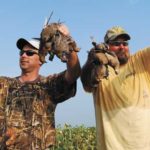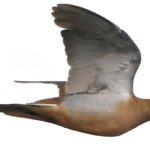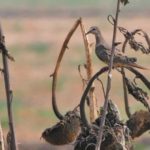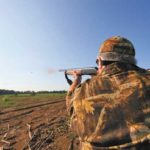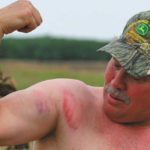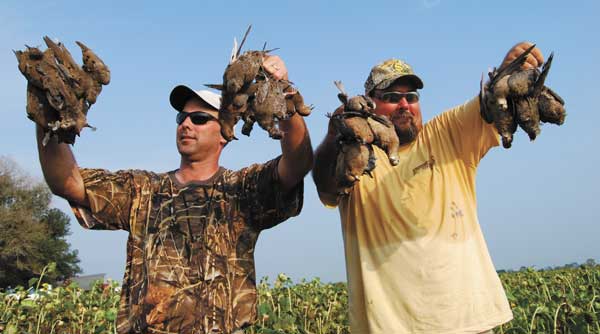
Keep the action coming with these tips from two dove experts.
A hangover descends over Louisiana dove hunters the Monday after opening weekend. Getting to shoot our guns for two days after we haven’t been able to shoot them for almost six months is on the same level as tossing back two Hurricanes after six months of staying sober. The euphoria, whether it comes naturally in the dove field or chemically from the alcohol, makes us feel 10-feet tall and bullet proof.
Then comes the morning after. While a lush would probably just grab another drink to help cure the hangover, dove hunters are left wondering what to do.
Whether they have to go back to work on Monday morning or they find their dove fields empty, there doesn’t appear to be any hair of the dog that bit them to help them make it through the day.
Hair of the dog? For those unfamiliar with the phrase, it is an English expression that implies that the best way to get rid of a hangover is to have another drink.
The hair-of-the-dog metaphor actually had a literal but erroneous beginning as a method of treating a dog bite during the late 1800s. Some Europeans at that time thought the best way to treat a dog bite was to place a few hairs from the dog that bit you in the wound.
Take heart dove hunters because the cure for the hangover following your opening weekend high takes the metaphor and brings it back full circle to its literal beginning. Only this time it’s not erroneous, and this time it will work.
The best way to cure your dove-hunting hangover is to go shoot some more doves — the feather of the dove that buzzed you.
Believe it or not, there will be plenty of doves left in the state after Sept. 6 and 7. They will be there on September 8, 9, 10, 11 and 12. And, yes, they’ll even be there on the Sept. 13 when the strongest force that keeps dove hunters out of their fields, the opening of another hunting season, makes its first appearance. In this case, the competing season is teal.
Not only are there doves to be shot during the first split, there are just as many, if not more, to be shot during the second and third split. Now, the casual dove hunters among us may not even realize that there is a second and third split.
“We actually have some of our best hunts of the year during the second and third splits,” said Mark Atwell of Atwell Guide Service.
This year, the doves splits in the south zone are Sept. 6-14 for the first split, Oct. 18-Nov. 30 for the second split, and the third split runs Dec. 20-Jan. 5.
The dates for the north zone are a little bit different with the first split running Sept. 6-21. The second split is Oct. 11-Nov. 9, and the third split is Dec. 13-Jan. 5.
Other than the fact that opening weekend dove hunters get distracted by other hunting seasons, perhaps the primary reason for the dove-hunting hangover is because many hunters mistakenly believe it’s game over once they shoot all their resident birds.
“I’m convinced that when you hit them hard, you can shoot them out of a field,” said LDWF wildlife biologist Mike Olinde. “So if you have somebody out there shooting them late on opening day, they’re going to see fewer birds when they go back the next day. But if you don’t hammer them, and you get out early, those doves will probably stay put.”
Olinde believes shooting them hard does two things to a local dove population. First, a bunch of hunters all killing birds out of the same field can put a serious dent in the localized population. Second, the doves that make it through that opening-day hunt tend to look for greener pastures where they don’t get harassed, just like ducks do.
The thing that turns most hunters off of dove hunting after the opening weekend is obviously a lack of birds. Say they do go out the second weekend to hunt a field that they pounded on opening day.
Well, being that the migrant doves haven’t started making their way to Louisiana yet, they’ll get disappointed when they have very few shots. Do you think they’re going to come back during the second split if the end of the first split was already poor in their eyes?
“That’s why we have a short first split and why we don’t start the second split until October,” Olinde explained. “When you’re out there hitting your local birds, and there aren’t any new birds coming in, you kind of push the limit on the resident birds.”
Another variable that will push dove hunters out of a field as quickly as it does the doves is the movement of a cold front through the state during the first split. However, these early fronts can be deceptive, as they don’t bring any new birds in like the ones during the second and third splits do.
Hunters automatically think it’s not worth hunting if the fronts are rolling through because they’re conditioned to them moving a dove population out rather than bringing a new population in.
“That’s one reason our second and third split is just as good or better than the first split,” said Atwell. “What happens is we sit on top of resident birds right before the first split, then a front comes in. And it doesn’t even have to be a real front — it could be just a good north wind. We lose all those birds we were holding.
“We’re sitting here begging for the fronts to stay away throughout the first split so we can shoot the resident birds. But when October comes, we’re begging for the fronts to roll through so we can build more birds.”
Although many hunters believe that early-season cold fronts can push doves entirely out of the state — just ask anybody who works on an oil rig about the numbers of birds they see flying over during September — that’s not entirely the case.
“I think we have more of a shifting of birds rather than a full-scale exodus,” said Olinde. “Auburn University in Alabama conducted a study relative to cold fronts, and what they found was that birds didn’t just pick up and move from an area. Rather, they simply dispersed within about a 15- to 20-mile area. They didn’t just leave the world.”
Although he recognizes many birds may leave an area, Olinde’s belief that it is more of a shifting of birds within a region rather than a complete exit is also based on some of the things he has seen working with banded doves.
“I got a bird back from Mexico just a few days ago,” Olinde said in early August. “That was the first one I’ve had out of over 10,000 birds that came from Mexico. I got some from Texas, which is what you might imagine, but birds do weird things. I had birds that I banded in July get shot in Missouri, north Georgia and Alabama, so they don’t all go to Texas and on in to Mexico.”
Atwell concurred with Olinde, and said everything being equal with fronts, food, etc., he typically won’t keep the same number of birds throughout the first split. In fact, he said after he shoots his resident birds, he’s got about a 50/50 chance of making another shoot the following weekend because his hunters thin them out so much.
“But if you talk with hunters in North Louisiana, they’ll tell you that their hunting gets better at the end of the first split,” he added. “That’s why they fought so hard to go back to the zone system. They would shoot nine days and still be sitting on a ton of birds.”
With so many variables that can affect first-split hunting success, it’s no wonder so many people who just wanted the opportunity to shoot their shotguns get so easily distracted by the opening of squirrel and archery seasons. While the opportunistic dove hunters are off doing other things, the real bird hunters know that all this confusion gets laid to rest at the beginning of the second split.
“Our prime hunting is the second split,” Atwell said. “That’s when we get the migration of birds in, and our hunting is a lot more consistent. The three things you need to hold birds are food, water and roost. If you’ve got those three things during the second split, you’ll be wrapped up in doves”
And dove-hunting fortunes can change dramatically during the second split. Atwell has seen times when he has gone from holding maybe 100 birds to 600 birds literally overnight.
“It’s just that quick,” he said. “Say a front comes through this morning. We won’t see anything today, but by tomorrow morning they’ll be everywhere. And since we generally see about one front a week during the second split, the entire state is constantly building up its dove population.”
Atwell sees some differences in hunting the birds during the first and second split that he feels might help bird hunters all across Louisiana have more successful second- and third-split hunts.
During these later hunts, Atwell recommends moving from the 1- and 1 1/8-ounce loads to full blown 1 1/4-ounce 7 1/2s because of the longer shots required during late-season hunts.
“There are just as many or even more birds than there are during the first split, but those birds are kind of like ducks in that they get a little wilder that time of year,” he said. “You also have more wind and weather to deal with when you’re shooting, and the more powerful shells are going to help you down more birds.”
Atwell also recommended covering up a little more during the second and third splits. Whereas hunters can get by with crouching down next to a fence row during the first split, having a little more cover is important if you want to get the more wary birds within shooting range.
“I have hunters who bring camo netting with them all the time during later parts of the dove season,” said Atwell. “They either wrap it around four posts that they drive into the ground, or they just drape it across a barbed-wired fence. Either way, it gives them just enough concealment to get more shots.”
While Louisiana’s dove population increases with each passing cold front, Olinde cautioned that some of the things that make the late-season hunting great also can make it a little more difficult.
“Doves will go where the food is,” he said. “And during the first split, there isn’t that much of it on the ground, so the birds concentrate in very specific areas. However, by the time the other splits roll around, there is a lot more agriculture being cut. That means you’re not the only game in town come those other two splits.”
Since the doves have more options when it comes to places to feed, they may not stick around very long in your field if you hammer them every day. Why would they want to try to eat your food while you’re shooting at them when they can move to the next field over where there aren’t any surprises waiting on them?
“The birds will disperse a little easier later in the season than they will during the first split,” said Olinde. “What that means for hunters is they have to be willing to move around a little more to stay where the birds are.”
And it also may mean knocking on a few doors to ask for permission to shoot a field that doesn’t belong to you. With that said, though, Olinde added that doves are pretty traditional in their patterns. If you are in the right area, they will come to you if you have the right stuff — food, water and roost.
“Plan your second- and third-split hunts around the weather,” Atwell advised. “Try to be out there the morning after a front moves through. There’s a reason some of your buddies tell you after you get out of your deer stand that you should of gone dove hunting instead.”
The reason is that they know there are more doves in the fields than there are deer in the woods. And while they certainly enjoyed having them all to themselves, they probably wouldn’t mind if you joined them for a day-after dove hunt.
While the hair of the dog probably does more harm than it does benefit, the feather of the dove will keep you coming back for more.
